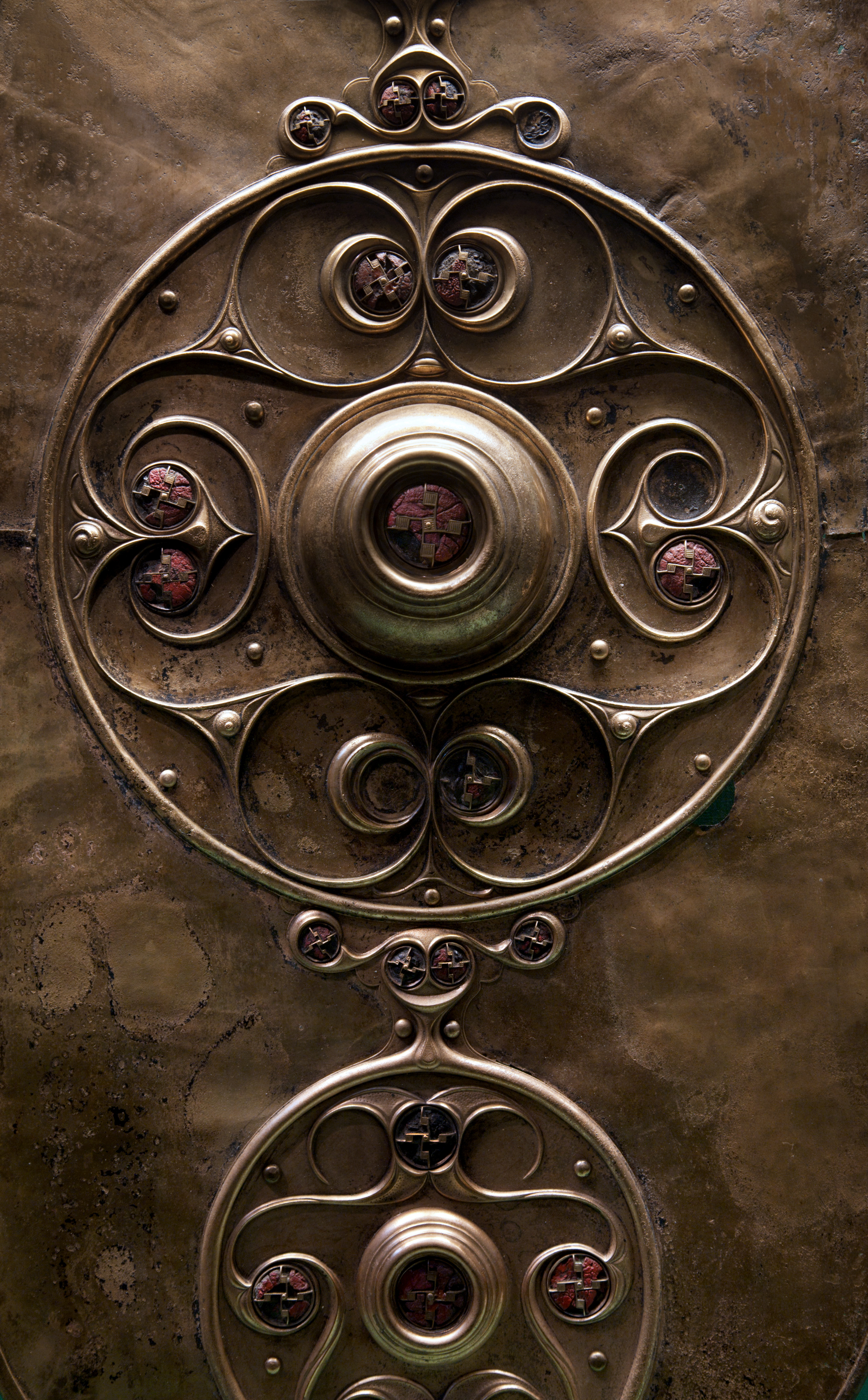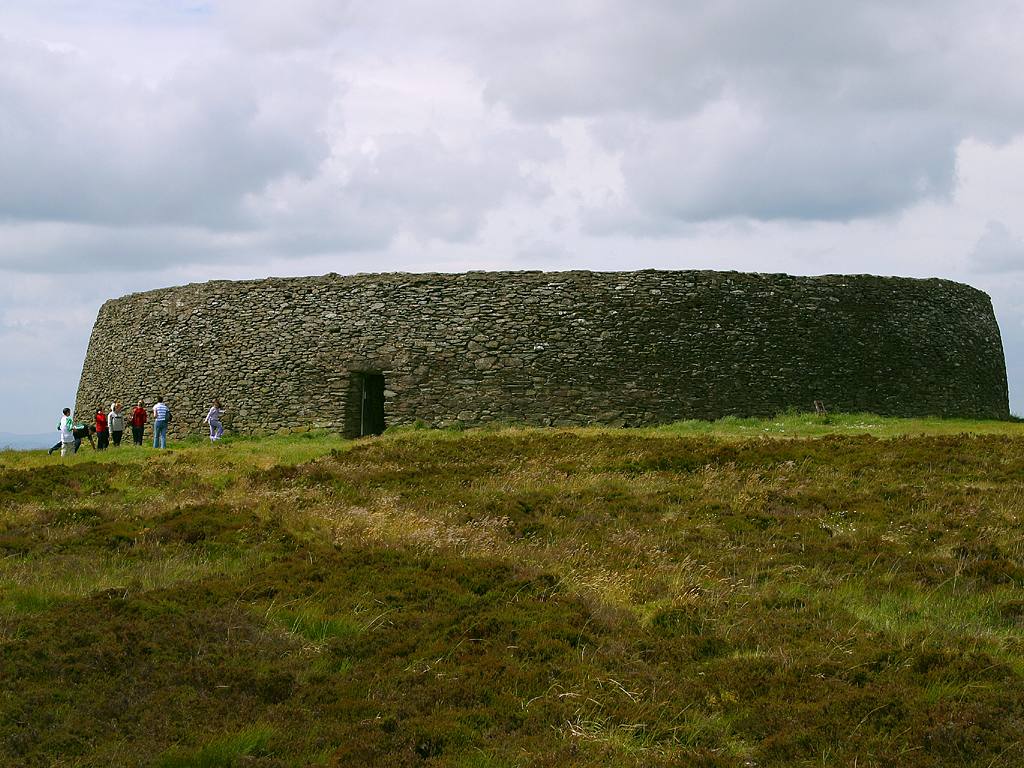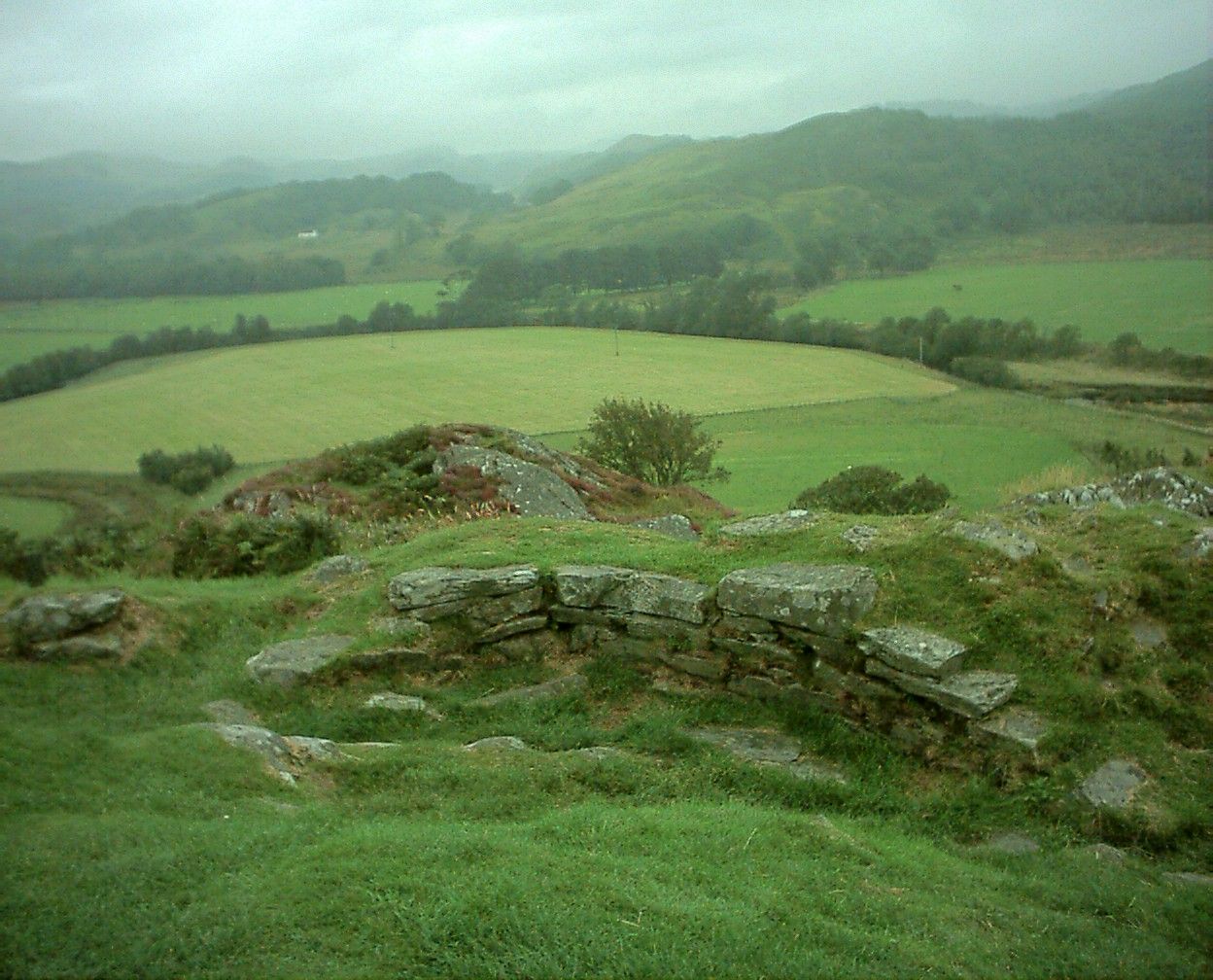|
Caer Euni
Caer Euni rid reference is an Iron Age hillfort, about north-east of the village of Llandderfel and about north-east of Bala Lake, in Gwynedd, Wales. It is a scheduled monument. Description The fort is situated on a narrow ridge, at height . It is an elongated enclosure, length about and width , orientated north-east to south-west, aligned with the ridge.Christopher Houlder. ''Wales: An Archaeological Guide''. Faber and Faber, 1978. Page 84. There is a rampart enclosing the inner area, with a steep slope to the south-east and ditches and counterscarps elsewhere. The principal entrance is in the north-east. The fort was enlarged: there is a bank, formerly the south-west end, traceable across the interior, and further defences were built to the south-west, notably a large rock-cut ditch and a rampart built with the stone from the ditch. The sites of about 25 round huts, diameter , have been detected, mostly in the later part of the enclosure. There are some burnt stones in the ... [...More Info...] [...Related Items...] OR: [Wikipedia] [Google] [Baidu] |
Llandderfel
Llandderfel is a village and a sparsely populated community in Gwynedd, Wales, near Bala, formerly served by the Llandderfel railway station. The community also includes the settlements of Glan-yr-afon, Llanfor, Cefnddwysarn and Frongoch. The Community population taken at the 2011 census was 1,095. Palé Hall Palé Hall was built in 1871, on the site of an older manor house in Llandderfel. It was designed by Samuel Pountney Smith of Shrewsbury for Henry Robertson MP, a railway engineer and local landowner. The house was used as a military hospital in World War I and a home for evacuated children in World War II. The Robertson family sold the estate to the Duke of Westminster in the 1950s. St Derfel's Church The parish church of Llandderfel is dedicated to Saint Derfel. It is part of the diocese of St Asaph and is mentioned in the Papal Registers of the late 15th century. Originally a Celtic Llan site, founded by Derfel in the early 6th century, the church was rebui ... [...More Info...] [...Related Items...] OR: [Wikipedia] [Google] [Baidu] |
Hillfort
A hillfort is a type of fortification, fortified refuge or defended settlement located to exploit a rise in elevation for defensive advantage. They are typical of the late Bronze Age Europe, European Bronze Age and Iron Age Europe, Iron Age. Some were used in the post-Roman Empire, Roman period. The fortification usually follows the contours of a hill and consists of one or more lines of Earthworks (Archaeology), earthworks or stone Rampart (fortification), ramparts, with stockades or defensive walls, and external ditches. If enemies were approaching, the inhabitants would spot them from a distance. Prehistoric Europe saw a growing population. It has been estimated that in about 5000 BC during the Neolithic between 2 million and 5 million lived in Europe; in the Late Iron Age it had an estimated population of around 15 to 30 million. Outside Greece and Italy, which were more densely populated, the vast majority of settlements in the Iron Age were small, with ... [...More Info...] [...Related Items...] OR: [Wikipedia] [Google] [Baidu] |
British Iron Age
The British Iron Age is a conventional name used in the archaeology of Great Britain, referring to the prehistoric and protohistoric phases of the Iron Age culture of the main island and the smaller islands, typically excluding prehistoric Ireland, which had an Iron Age Ireland, independent Iron Age culture of its own. The Iron Age is not an archaeological horizon of common artefacts but is rather a locally-diverse cultural phase. The British Iron Age followed the Bronze Age Britain, British Bronze Age and lasted in theory from the first significant use of iron for tools and weapons in Britain to the Romano-British culture, Romanisation of the southern half of the island. The Romanised culture is termed Roman Britain and is considered to supplant the British Iron Age. The tribes living in Britain during this time are often popularly considered to be part of a broadly-Celts, Celtic culture, but in recent years, that has been disputed. At a minimum, "Celtic" is a linguistic ter ... [...More Info...] [...Related Items...] OR: [Wikipedia] [Google] [Baidu] |
Hillfort
A hillfort is a type of fortification, fortified refuge or defended settlement located to exploit a rise in elevation for defensive advantage. They are typical of the late Bronze Age Europe, European Bronze Age and Iron Age Europe, Iron Age. Some were used in the post-Roman Empire, Roman period. The fortification usually follows the contours of a hill and consists of one or more lines of Earthworks (Archaeology), earthworks or stone Rampart (fortification), ramparts, with stockades or defensive walls, and external ditches. If enemies were approaching, the inhabitants would spot them from a distance. Prehistoric Europe saw a growing population. It has been estimated that in about 5000 BC during the Neolithic between 2 million and 5 million lived in Europe; in the Late Iron Age it had an estimated population of around 15 to 30 million. Outside Greece and Italy, which were more densely populated, the vast majority of settlements in the Iron Age were small, with ... [...More Info...] [...Related Items...] OR: [Wikipedia] [Google] [Baidu] |
Bala Lake
Bala Lake, or (), is a large freshwater glacial lake in Gwynedd, Wales. The River Dee, which has its source on the slopes of Dduallt in the mountains of Snowdonia, feeds the long by wide lake. It was the largest natural body of water in Wales even before its level was raised by Thomas Telford to provide water for the Ellesmere Canal (later Llangollen Canal). The town of Bala, which was once an important centre for the North Wales woollen trade, is located on the north-eastern end of the lake. The narrow-gauge Bala Lake Railway, between the town and Llanuwchllyn (whose name means "church llan'above uwch'the lake llyn'), runs along the lake's south-eastern shore using a section of former trackbed from the former Ruabon–Barmouth line. Toponyms Previous names Gerald of Wales records the lake in his 12th century ''Itinerarium Cambriae'' under the name ''Penmelesmere''. In his 1804 translation of Gerald's work, Sir Richard Colt Hoare states that the lake was also re ... [...More Info...] [...Related Items...] OR: [Wikipedia] [Google] [Baidu] |
Gwynedd
Gwynedd () is a county in the north-west of Wales. It borders Anglesey across the Menai Strait to the north, Conwy, Denbighshire, and Powys to the east, Ceredigion over the Dyfi estuary to the south, and the Irish Sea to the west. The city of Bangor is the largest settlement, and the administrative centre is Caernarfon. The preserved county of Gwynedd, which is used for ceremonial purposes, includes the Isle of Anglesey. Gwynedd is the second largest county in Wales but sparsely populated, with an area of and a population of 117,400. After Bangor (18,322), the largest settlements are Caernarfon (9,852), Bethesda (4,735), and Pwllheli (4,076). The county has the highest percentage of Welsh speakers in Wales, at 64.4%, and is considered a heartland of the language. The geography of Gwynedd is mountainous, with a long coastline to the west. The county contains much of Snowdonia (), a national park which contains Wales's highest mountain, Snowdon (; ). To the west, t ... [...More Info...] [...Related Items...] OR: [Wikipedia] [Google] [Baidu] |
Scheduled Monument
In the United Kingdom, a scheduled monument is a nationally important archaeological site or historic building, given protection against unauthorised change. The various pieces of legislation that legally protect heritage assets from damage, visual disturbance, and destruction are grouped under the term "Designation (heritage assets), designation". The protection provided to scheduled monuments is given under the Ancient Monuments and Archaeological Areas Act 1979, which is a different law from that used for listed buildings (which fall within the town and country planning system). A heritage asset is a part of the historic environment that is valued because of its historic, archaeological, architectural or artistic interest. Only some of these are judged to be important enough to have extra legal protection through designation. There are about 20,000 scheduled monuments in England representing about 37,000 heritage assets. Of the tens of thousands of scheduled monuments in the UK ... [...More Info...] [...Related Items...] OR: [Wikipedia] [Google] [Baidu] |
Counterscarp
A scarp and a counterscarp are the inner and outer sides, respectively, of a ditch or moat used in fortifications. Attackers (if they have not bridged the ditch) must descend the counterscarp and ascend the scarp. In permanent fortifications, the scarp and counterscarp may be encased in stone. In less permanent fortifications, the counterscarp may be lined with paling fence set at an angle so as to give no cover to the attackers, but to make advancing and retreating more difficult. If an attacker succeeds in breaching a wall, a coupure can be dug on the inside of the wall to hinder the forlorn hope, in which case the side of the ditch furthest from the breached wall and closest to the centre of the fortification is also called the counterscarp. Counterscarp gallery These are tunnels or "galleries" that have been built behind the counterscarp wall inside the moat or ditch. Each gallery is pierced with loopholes for musketry, so that attacking forces which enter the moat can be ... [...More Info...] [...Related Items...] OR: [Wikipedia] [Google] [Baidu] |
Vitrified Fort
Vitrified forts are stone enclosures whose walls have been subjected to vitrification through heat. It was long thought that these structures were unique to Scotland, but they have since been identified in several other parts of western and northern Europe. Vitrified forts are generally situated on hills offering strong defensive positions. Their form seems to have been determined by the contour of the flat summits which they enclose. The walls vary in size, a few being upwards of high, and are so broad that they present the appearance of embankments. Weak parts of the defence are strengthened by double or triple walls, and occasionally vast lines of ramparts, composed of large blocks of unhewn and unvitrified stones, envelop the vitrified centre at some distance from it. The walls themselves are termed vitrified ramparts. Vitrification process No lime or cement has been found in any of these structures, all of them presenting the peculiarity of being more or less consolidat ... [...More Info...] [...Related Items...] OR: [Wikipedia] [Google] [Baidu] |
Hillforts In Britain
Hillforts in Britain refers to the various hillforts within the island of Great Britain. Although the earliest such constructs fitting this description come from the Neolithic British Isles, with a few also dating to later Bronze Age Britain, British hillforts were primarily constructed during the British Iron Age. Some of these were apparently abandoned in the southern areas that were a part of Roman Britain, although at the same time, those areas of northern Britain that remained free from Roman occupation saw an increase in their construction. Some hillforts were reused in the Early Middle Ages, and in some rarer cases, into the later medieval period as well. By the early modern period, these had essentially all been abandoned, with many being excavated by archaeology, archaeologists in the nineteenth century onward. There are around 3,300 structures that can be classed as hillforts or similar "defended enclosures" within Britain. Most of these are clustered in certain regions: s ... [...More Info...] [...Related Items...] OR: [Wikipedia] [Google] [Baidu] |
List Of Scheduled Prehistoric Monuments In Gwynedd (former Merionethshire)
A list is a set of discrete items of information collected and set forth in some format for utility, entertainment, or other purposes. A list may be memorialized in any number of ways, including existing only in the mind of the list-maker, but lists are frequently written down on paper, or maintained electronically. Lists are "most frequently a tool", and "one does not ''read'' but only ''uses'' a list: one looks up the relevant information in it, but usually does not need to deal with it as a whole".Lucie Doležalová,The Potential and Limitations of Studying Lists, in Lucie Doležalová, ed., ''The Charm of a List: From the Sumerians to Computerised Data Processing'' (2009). Purpose It has been observed that, with a few exceptions, "the scholarship on lists remains fragmented". David Wallechinsky, a co-author of ''The Book of Lists'', described the attraction of lists as being "because we live in an era of overstimulation, especially in terms of information, and lists help us ... [...More Info...] [...Related Items...] OR: [Wikipedia] [Google] [Baidu] |
Hillforts In Gwynedd
A hillfort is a type of fortified refuge or defended settlement located to exploit a rise in elevation for defensive advantage. They are typical of the late European Bronze Age and Iron Age. Some were used in the post-Roman period. The fortification usually follows the contours of a hill and consists of one or more lines of earthworks or stone ramparts, with stockades or defensive walls, and external ditches. If enemies were approaching, the inhabitants would spot them from a distance. Prehistoric Europe saw a growing population. It has been estimated that in about 5000 BC during the Neolithic between 2 million and 5 million lived in Europe; in the Late Iron Age it had an estimated population of around 15 to 30 million. Outside Greece and Italy, which were more densely populated, the vast majority of settlements in the Iron Age were small, with perhaps no more than 50 inhabitants. Hillforts were the exception, and were the home of up to 1,000 pe ... [...More Info...] [...Related Items...] OR: [Wikipedia] [Google] [Baidu] |









